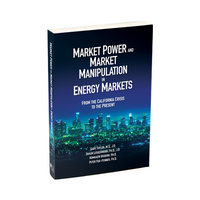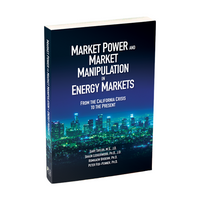Market Power and Market Manipulation in Energy Markets
In discussing the development of statutory and regulatory enforcement systems devised in the wake of the California Power Crisis, the book provides an analytical framework for understanding the legal and economic nuances associated with market manipulation in its various forms. Consistent with the logic of the manipulation enforcement actions recently brought by the FERC and CFTC, this framework provides perspective as to the future of manipulation compliance and enforcement under these agencies' continuing mandates.
This First Edition provides:
- An introduction to the similarities and differences between market power and market manipulation;
- A discussion of how market power may be diagnosed in electricity markets;
- An overview of the evolution of the Western Power Crisis;
- A chronicle of the litigation that stemmed from the Crisis;
- A study of the exercise of market power during the Crisis and the analytic techniques for identifying and measuring it in power markets;
- A discussion of Enron’s manipulative strategies that involved fraud rather than market power;
- An explanation of why the FERC’s then-existing regulatory systems were poorly suited to stop or remedy the Crisis;
- The evolution of the FERC’s Office of Enforcement and adoption of a fraud-based anti-manipulation rule;
- An economic framework for the analysis of market manipulation;
- A discussion of how to implement this framework for manipulation compliance and enforcement; and
- Application of the framework to recent manipulation cases prosecuted by the FERC and CFTC.
Details:
"Designed for attorneys, energy traders, compliance personnel, energy economists, regulators, and students, this book provides the reader with a unique understanding of market power and market manipulation in energy markets.”
-Peter Fox-Penner, Ph.D., Gary Taylor, J.D., Shaun Ledgerwood, Ph.D., J.D., Romkaew Broehm, Ph.D.
Details and Features:
AUTHORS: PETER FOX-PENNER, PH.D, GARY TAYLOR, J.D., SHAUN LEDGERWOOD, PH.D, J.D., and ROMKAEW BROEHM, PH.D
ISBN: 978-0-910325-34-9
7 x 10 inches
Paperback
293 pages
(c) 2015


Text Column
These text columns are great for showing off features or policies (such as shipping or return policy). Attach an image or an icon for more visual interest.
Read more →Text Column
These text columns are great for showing off features or policies (such as shipping or return policy). Attach an image or an icon for more visual interest.
Read more →Text Column
These text columns are great for showing off features or policies (such as shipping or return policy). Attach an image or an icon for more visual interest.
Read more →
